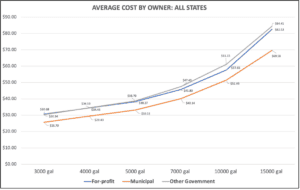TFTT Report
Another Report Falls Short with Rate Comparisons – Yet Again
Experts have warned time and time again that water rate comparisons are dangerous and unwise. After all, blindly comparing what customers pay on their water bills ignores inherent cost differences between systems and whether customers are receiving safe water and reliable service for the money that they pay. We learn nothing from rate comparisons between distressed systems serving undrinkable water and systems that properly invest and maintain reliable infrastructure that delivers a superior product.
Yet, here we are again with another report attempting to draw conclusions about water services through rate comparisons.
The report compares the rates of “municipally owned systems” and “for-profit systems” (a descriptor that perhaps aims to stir fear in the hearts of readers). And while the report did find that municipal controlled systems on average charge lower rates, the data also show that “other governments” – this includes systems owned and operated by special districts and water authorities – have customer rates that are on par with, or even higher, than those of regulated, private water systems, like NAWC members.
This begs the question: Is it truly that the “for-profits” have “higher” rates or are municipally controlled systems the outliers on the low end due to a lack of investment, larger service populations, and/or subsidies from other revenue sources, like taxes, that make rates appear lower than the true cost of service?
Obviously, a major driver of rates is the amount that a system invests in maintaining and upgrading its infrastructure – a point that was raised in NRDC’s analysis of the new report. NRDC notes that while the “study finds incredibly wide variation in bills within states, and even within metropolitan areas” one state – Wisconsin – had far more congruence among its systems.
The reason?
“Wisconsin displayed much less variation; it’s likely no coincidence that Wisconsin is the only state where the state utility commission regulates water rates for all systems.”
In other words, thanks to the independent state utility commission’s regulation focused on matching rates to infrastructure needs, municipal systems in Wisconsin are likely investing on par with private and “other government” systems. Meanwhile, municipal systems in other states are not regulated by state utility commissions and investment decisions are left to local politicians who often forego necessary upgrades to keep rates low (and protect their reelection chances).
This phenomenon has been pointed out before. In their study, “When Governments Regulate Governments,” Manny Teodoro (University of Wisconsin) and David Konisky (Georgetown University) found that, since rate increases are politically challenging for local government officials, it is more difficult for municipal utilities to generate the revenue necessary for upgrades and routine maintenance. As a result, those municipal utilities are more likely to miss or delay crucial investments, thereby generating more violations of federal safe drinking water standards.
Bottom line, all of this shows, once again, that what is presented as a straightforward rate comparison really doesn’t tell the whole story. While municipally run systems may have their water infrastructure decisions politicized, customers of NAWC member companies can be sure their regulated, private water provider is solely focused on providing the safest water and the most reliable service – all in an environment where costs are closely regulated by state utility commissions.

